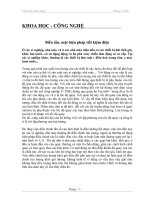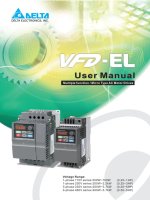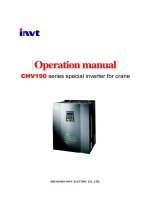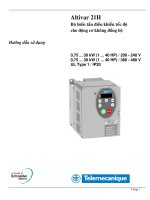Biến tần Delta
Bạn đang xem bản rút gọn của tài liệu. Xem và tải ngay bản đầy đủ của tài liệu tại đây (4.77 MB, 207 trang )
Preface
Thank you for choosing DELTA’s multifunction VFD-EL Series. The VFD-EL Series is manufactured
with high-quality components and materials and incorporate the latest microprocessor technology
available.
This manual is to be used for the installation, parameter setting, troubleshooting, and daily
maintenance of the AC motor drive. To guarantee safe operation of the equipment, read the following
safety guidelines before connecting power to the AC motor drive. Keep this operating manual at
hand and distribute to all users for reference.
To ensure the safety of operators and equipment, only qualified personnel familiar with AC motor
drive are to do installation, start-up and maintenance. Always read this manual thoroughly before
using VFD-EL series AC Motor Drive, especially the WARNING, DANGER and CAUTION notes.
Failure to comply may result in personal injury and equipment damage. If you have any questions,
please contact your dealer.
PLEASE READ PRIOR TO INSTALLATION FOR SAFETY.
DANGER!
1. AC input power must be disconnected before any wiring to the AC motor drive is made.
2. A charge may still remain in the DC-link capacitors with hazardous voltages, even if the power
has been turned off. To prevent personal injury, please ensure that power has turned off before
opening the AC motor drive and wait ten minutes for the capacitors to discharge to safe voltage
levels.
3. Never reassemble internal components or wiring.
4. The AC motor drive may be destroyed beyond repair if incorrect cables are connected to the
input/output terminals. Never connect the AC motor drive output terminals U/T1, V/T2, and
W/T3 directly to the AC mains circuit power supply.
5. Ground the VFD-EL using the ground terminal. The grounding method must comply with the
laws of the country where the AC motor drive is to be installed. Refer to the Basic Wiring
Diagram.
6. VFD-EL series is used only to control variable speed of 3-phase induction motors, NOT for 1-
phase motors or other purpose.
7. VFD-EL series shall NOT be used for life support equipment or any life safety situation.
WARNING!
1. DO NOT use Hi-pot test for internal components. The semi-conductor used in AC motor drive
easily damage by high-voltage.
2. There are highly sensitive MOS components on the printed circuit boards. These components
are especially sensitive to static electricity. To prevent damage to these components, do not
touch these components or the circuit boards with metal objects or your bare hands.
3. Only qualified persons are allowed to install, wire and maintain AC motor drives.
CAUTION!
1. Some parameters settings can cause the motor to run immediately after applying power.
2. DO NOT install the AC motor drive in a place subjected to high temperature, direct sunlight,
high humidity, excessive vibration, corrosive gases or liquids, or airborne dust or metallic
particles.
3. Only use AC motor drives within specification. Failure to comply may result in fire, explosion or
electric shock.
4. To prevent personal injury, please keep children and unqualified people away from the
equipment.
5. When the motor cable between AC motor drive and motor is too long, the layer insulation of the
motor may be damaged. Please use a frequency inverter duty motor or add an AC output
reactor to prevent damage to the motor. Refer to appendix B Reactor for details.
6. The rated voltage for AC motor drive must be ≤ 240V (≤ 480V for 460V models) and the mains
supply current capacity must be ≤ 5000A RMS.
Table of Contents
Preface .............................................................................................................i
Table of Contents..........................................................................................iii
Chapter 1 Introduction................................................................................1-1
1.1 Receiving and Inspection....................................................................1-2
1.1.1 Nameplate Information................................................................ 1-2
1.1.2 Model Explanation ...................................................................... 1-2
1.1.3 Series Number Explanation ........................................................ 1-3
1.1.4 Drive Frames and Appearances ................................................. 1-3
1.1.5 Remove Instructions ................................................................... 1-5
1.2 Preparation for Installation and Wiring................................................1-5
1.2.1 Ambient Conditions..................................................................... 1-6
1.2.2 DC-bus Sharing: Connecting the DC-bus of the AC Motor Drives in
Parallel.................................................................................................
1-8
1.3 Dimensions.........................................................................................1-9
Chapter 2 Installation and Wiring ..............................................................2-1
2.1 Wiring .................................................................................................2-2
2.2 External Wiring ...................................................................................2-8
2.3 Main Circuit.........................................................................................2-9
2.3.1 Main Circuit Connection.............................................................. 2-9
2.3.2 Main Circuit Terminals .............................................................. 2-11
2.4 Control Terminals .............................................................................2-12
Chapter 3 Keypad and Start Up..................................................................3-1
3.1 Description of the Digital Keypad ....................................................... 3-1
3.2 How to Operate the Digital Keypad .................................................... 3-3
3.3 Reference Table for the 7-segment LED Display of the Digital Keypad3-
4
3.4 Operation Method .............................................................................. 3-4
3.5 Trial Run ............................................................................................ 3-5
Chapter 4 Parameters..................................................................................4-1
4.1 Summary of Parameter Settings ........................................................ 4-2
4.2 Parameter Settings for Applications ................................................. 4-20
4.3 Description of Parameter Settings.................................................... 4-25
Chapter 5 Troubleshooting.........................................................................5-1
5.1 Over Current (OC).............................................................................. 5-1
5.2 Ground Fault ...................................................................................... 5-2
5.3 Over Voltage (OV).............................................................................. 5-2
5.4 Low Voltage (Lv) ................................................................................ 5-3
5.5 Over Heat (OH1) ................................................................................ 5-4
5.6 Overload ............................................................................................ 5-4
5.7 Keypad Display is Abnormal .............................................................. 5-5
5.8 Phase Loss (PHL) .............................................................................. 5-5
5.9 Motor cannot Run............................................................................... 5-6
5.10 Motor Speed cannot be Changed .................................................... 5-7
5.11 Motor Stalls during Acceleration....................................................... 5-8
5.12 The Motor does not Run as Expected.............................................. 5-8
5.13 Electromagnetic/Induction Noise...................................................... 5-9
5.14 Environmental Condition...................................................................5-9
5.15 Affecting Other Machines ...............................................................5-10
Chapter 6 Fault Code Information and Maintenance................................6-1
6.1 Fault Code Information .......................................................................6-1
6.1.1 Common Problems and Solutions............................................... 6-1
6.1.2 Reset .......................................................................................... 6-5
6.2 Maintenance and Inspections .............................................................6-5
Appendix A Specifications........................................................................ A-1
Appendix B Accessories ........................................................................... B-1
B.1 All Brake Resistors & Brake Units Used in AC Motor Drives............. B-1
B.1.1 Dimensions and Weights for Brake Resistors ............................ B-4
B.2 Non-fuse Circuit Breaker Chart ......................................................... B-7
B.3 Fuse Specification Chart ................................................................... B-8
B.4 AC Reactor........................................................................................ B-9
B.4.1 AC Input Reactor Recommended Value.....................................B-9
B.4.2 AC Output Reactor Recommended Value..................................B-9
B.4.3 Applications ..............................................................................B-10
B.5 Zero Phase Reactor (RF220X00A) ................................................. B-12
B.6 Remote Controller RC-01................................................................ B-14
B.7 PU06 ............................................................................................... B-15
B.7.1 Description of the Digital Keypad VFD-PU06 ...........................B-15
B.7.2 Explanation of Display Message...............................................B-15
B.7.3 Operation Flow Chart ............................................................... B-16
B.8 Fieldbus Modules ............................................................................ B-17
B.8.1 DeviceNet Communication Module (CME-DN01) .....................B-17
B.8.1.1 Panel Appearance and Dimensions ..................................B-17
B.8.1.2 Wiring and Settings ...........................................................B-17
B.8.1.3 Power Supply ....................................................................B-18
B.8.1.4 LEDs Display.....................................................................B-18
B.8.2 LonWorks Communication Module (CME-LW01) .....................B-18
B.8.2.1 Introduction .......................................................................B-18
B.8.2.2 Dimensions .......................................................................B-18
B.8.2.3 Specifications ....................................................................B-19
B.8.2.4 Wiring ................................................................................B-19
B.8.2.5 LED Indications .................................................................B-19
B.8.3 Profibus Communication Module (CME-PD01).........................B-20
B.8.3.1 Panel Appearance.............................................................B-20
B.8.3.2 Dimensions .......................................................................B-21
B.8.3.3 Parameters Settings in VFD-EL ........................................B-21
B.8.3.4 Power Supply ....................................................................B-21
B.8.3.5 PROFIBUS Address..........................................................B-21
B.8.4 CME-COP01 (CANopen) ..........................................................B-22
B.8.4.1 Product Profile...................................................................B-22
B.8.4.2 Specifications ....................................................................B-22
B.8.4.3 Components......................................................................B-23
B.8.4.4 LED Indicator Explanation & Troubleshooting...................B-24
B.9 MKE-EP & DIN Rail ......................................................................... B-26
B.9.1 MKE-EP ....................................................................................B-26
B.9.2 DIN Rail (Only for frame A) .......................................................B-27
Appendix C How to Select the Right AC Motor Drive.............................. C-1
C.1 Capacity Formulas ............................................................................ C-2
C.2 General Precaution ........................................................................... C-4
C.3 How to Choose a Suitable Motor....................................................... C-5
This page intentionally le ft blank
Revision June 2007, 0ELE, V1.00 1-1
Chapter 1 Introduction
The AC motor drive should be kept in the shipping carton or crate before installation. In order to
retain the warranty coverage, the AC motor drive should be stored properly when it is not to be used
for an extended period of time. Storage conditions are:
CAUTION!
1. Store in a clean and dry location free from direct sunlight or corrosive fumes.
2. Store within an ambient temperature range of -20
°
C to +60
°
C.
3. Store within a relative humidity range of 0% to 90% and non-condensing environment.
4. Store within an air pressure range of 86 kPA to 106kPA.
5. DO NOT place on the ground directly. It should be stored properly. Moreover, if the surrounding
environment is humid, you should put exsiccator in the package.
6. DO NOT store in an area with rapid changes in temperature. It may cause condensation and
frost.
7. If the AC motor drive is stored for more than 3 months, the temperature should not be higher
than 30 °C. Storage longer than one year is not recommended, it could result in the degradation
of the electrolytic capacitors.
8. When the AC motor drive is not used for longer time after installation on building sites or places
with humidity and dust, it’s best to move the AC motor drive to an environment as stated above.
Chapter 1 Introduction|
1-2 Revision June 2007, 0ELE, V1.00
1.1 Receiving and Inspection
This VFD-EL AC motor drive has gone through rigorous quality control tests at the factory before
shipment. After receiving the AC motor drive, please check for the following:
Check to make sure that the package includes an AC motor drive, the User Manual/Quick
Start and CD.
Inspect the unit to assure it was not damaged during shipment.
Make sure that the part number indicated on the nameplate corresponds with the part
number of your order.
1.1.1 Nameplate Information
Example for 1HP/0.75kW 3-phase 230V AC motor drive
MODEL VFD007EL23A
:
INPUT :3PH 200-240V 50/60Hz 5.1A
OUTPUT :3PH 0-240V 4.2A 1.6kVA 0.75kW/1HP
FREQUENCY RANGE : 0.1~600Hz
Serial Number & Bar Code
AC Drive Model
Input Spec.
Output Spec.
Output Frequency Range
007EL23A0T7140001
00.92
Software Version
1.1.2 Model Explanation
VFD
A
Version Type
23
Mains Input Voltage
11:115 phaseV 1-
21: phase230V 1-
23:230 phaseV 3-
EL
VFD-EL Series
007
Applicable motor capacity
004: 0.5 HP(0.4kW)
015: 2 HP(1.5kW)
022: 3 HP(2.2kW)
Series Name ( ariable requency rive)
VF D
43:460 phaseV 3-
002: 0.25 HP(0.2kW)
037: 5 HP(3.7kW)
A: Standard drive
Chapter 1 Introduction|
Revision June 2007, 0ELE, V1.00 1-3
1.1.3 Series Number Explanation
0170T007EL23A
Production number
Production year 2007
Production factory
Production week
T: Taoyuan, W: Wujiang
Model
230V 3-phase 1HP(0.75kW)
If the nameplate information does not correspond to your purchase order or if there are
any problems, please contact your distributor.
1.1.4 Drive Frames and Appearances
0.25-2HP/0.2-1.5kW (Frame A) 1-15HP/0.75-11kW (Frame B)
Input terminals
(R/L1, S/L2, T/L3)
Digital keypad
Output terminals
(U/T1, V/T2, W/T3)
Control board cover
Input terminals cover
(R/L1, S/L2, T/L3)
Case body
Digital keypad
Output terminals cover
(U/T1, V/T2, W/T3)
Control board cover
Chapter 1 Introduction|
1-4 Revision June 2007, 0ELE, V1.00
Internal Structure
Digital keypad
ACI/AVI
RS485 port (RJ-45)
NPN/PNP
RFI Jumper Location
at the right side
NOTE
RFI jumper is near the input terminals as shown in the above figure and can be removed by taking
off screws.
Frame Power range Models
A 0.25-2hp (0.2-1.5kW)
VFD002EL11A/21A/23A,
VFD004EL11A/21A/23A/43A,
VFD007EL21A/23A/43A, VFD015EL23A/43A
B 1-5hp (0.75-3.7kW)
VFD007EL11A, VFD015EL21A,
VFD022EL21A/23A/43A, VFD037EL23A/43A
Chapter 1 Introduction|
Revision June 2007, 0ELE, V1.00 1-5
RFI Jumper
RFI Jumper: The AC motor drive may emit the electrical noise. The RFI jumper is used to suppress
the interference (Radio Frequency Interference) on the power line.
Main power isolated from earth:
If the AC motor drive is supplied from an isolated power (IT power), the RFI jumper must be cut off.
Then the RFI capacities (filter capacitors) will be disconnected from ground to prevent circuit damage
(according to IEC 61800-3) and reduce earth leakage current.
CAUTION!
1. After applying power to the AC motor drive, do not cut off the RFI jumper. Therefore,
please make sure that main power has been switched off before cutting the RFI jumper.
2. The gap discharge may occur when the transient voltage is higher than 1,000V. Besides,
electro-magnetic compatibility of the AC motor drives will be lower after cutting the RFI
jumper.
3. Do NOT cut the RFI jumper when main power is connected to earth.
4. The RFI jumper cannot be cut when Hi-pot tests are performed. The mains power and
motor must be separated if high voltage test is performed and the leakage currents are
too high.
5. To prevent drive damage, the RFI jumper connected to ground shall be cut off if the AC
motor drive is installed on an ungrounded power system or a high resistance-grounded
(over 30 ohms) power system or a corner grounded TN system.
1.1.5 Remove Instructions
1.2 Preparation for Installation and Wiring
Remove Front Cover
Step 1 Step 2
Remove Fan
Chapter 1 Introduction|
1-6 Revision June 2007, 0ELE, V1.00
1.2.1 Ambient Conditions
Install the AC motor drive in an environment with the following conditions:
Air Temperature:
-10 ~ +50°C (14 ~ 122°F) for UL & cUL
-10 ~ +40°C (14 ~ 104°F) for side-by-side mounting
Relative Humidity: <90%, no condensation allowed
Atmosphere
pressure:
86 ~ 106 kPa
Installation Site
Altitude:
<1000m
Operation
Vibration:
<20Hz: 9.80 m/s
2
(1G) max
20 ~ 50Hz: 5.88 m/s
2
(0.6G) max
Temperature: -20°C ~ +60°C (-4°F ~ 140°F)
Relative Humidity: <90%, no condensation allowed
Atmosphere
pressure:
86 ~ 106 kPa
Storage
Transportation
Vibration:
<20Hz: 9.80 m/s
2
(1G) max
20 ~ 50Hz: 5.88 m/s
2
(0.6G) max
Pollution
Degree
2: good for a factory type environment.
Minimum Mounting Clearances
Frame A Mounting Clearances
Option 1 (-10 to +50°C) Option 2 (-10 to +40°C)
Air flow
120mm
120mm
5
0
m
m
5
0
m
m
120mm
120mm
5
0
m
m
5
0
m
m
Air Flow
Chapter 1 Introduction|
Revision June 2007, 0ELE, V1.00 1-7
Frame B Mounting Clearances
Option 1 (-10 to +50°C) Option 2 (-10 to +40°C)
Air flow
150mm
150mm
5
0
m
m
5
0
m
m
150mm
150mm
5
0
m
m
5
0
m
m
Air Flow
CAUTION!
1. Operating, storing or transporting the AC motor drive outside these conditions may cause
damage to the AC motor drive.
2. Failure to observe these precautions may void the warranty!
3. Mount the AC motor drive vertically on a flat vertical surface object by screws. Other directions
are not allowed.
4. The AC motor drive will generate heat during operation. Allow sufficient space around the unit
for heat dissipation.
5. The heat sink temperature may rise to 90°C when running. The material on which the AC motor
drive is mounted must be noncombustible and be able to withstand this high temperature.
6. When AC motor drive is installed in a confined space (e.g. cabinet), the surrounding
temperature must be within 10 ~ 40°C with good ventilation. DO NOT install the AC motor drive
in a space with bad ventilation.
7. Prevent fiber particles, scraps of paper, saw dust, metal particles, etc. from adhering to the
heatsink.
8. When installing multiple AC more drives in the same cabinet, they should be adjacent in a row
with enough space in-between. When installing one AC motor drive below another one, use a
metal separation between the AC motor drives to prevent mutual heating.
Chapter 1 Introduction|
1-8 Revision June 2007, 0ELE, V1.00
Installation with Metal Separation Installation without Metal Separation
Air flow
Frame A
Frame B
120mm
120mm
120mm
120mm
150mm
150mm
150mm
150mm
120mm
120mm
150mm
150mm
A
B
A
B
Frame A
Frame B
1.2.2 DC-bus Sharing: Connecting the DC-bus of the AC Motor Drives
in Parallel
1. This function is not for 115V models.
2. The AC motor drives can absorb mutual voltage that generated to DC bus when
deceleration.
3. Enhance brake function and stabilize the voltage of the DC bus.
4. The brake module can be added to enhance brake function after connecting in parallel.
5. Only the same power system can be connected in parallel.
6. It is recommended to connect 5 AC motor drives in parallel (no limit in horsepower).
Chapter 1 Introduction|
Revision June 2007, 0ELE, V1.00 1-9
Power 208/220/230/380/440/480 (depend on models)
power should be applied at the same time
(only the same power system can be connected in parallel)
For frame A and B, terminal + (-) is connected to the terminal + (-) of the braking module.
U V W U V W U V W U V W
IM IM IM IM
Braking
modules
1.3 Dimensions
(Dimensions are in millimeter and [inch])
D
D
W
H H1
W1
Frame W W1 H H1 D Ø ØD
A 72.0[2.83] 59.0[2.32] 174.0[6.86] 151.6[5.97] 136.0[5.36] 5.4[0.21] 2.7[0.11]
B 100.0[3.94] 89.0[3.50] 174.0[6.86] 162.9[6.42] 136.0[5.36] 5.4[0.21] 2.7[0.11]
Chapter 1 Introduction|
1-10 Revision June 2007, 0ELE, V1.00
NOTE
Frame A: VFD002EL11A/21A/23A, VFD004EL11A/21A/23A/43A, VFD007EL21A/23A/43A,
VFD015EL23A/43A
Frame B: VFD007EL11A, VFD015EL21A, VFD022EL21A/23A/43A, VFD037EL23A/43A
Revision June 2007, 0ELE, V1.00
2-1
Chapter 2 Installation and Wiring
After removing the front cover, check if the power and control terminals are clear. Be sure to observe
the following precautions when wiring.
General Wiring Information
Applicable Codes
All VFD-EL series are Underwriters Laboratories, Inc. (UL) and Canadian Underwriters
Laboratories (cUL) listed, and therefore comply with the requirements of the National
Electrical Code (NEC) and the Canadian Electrical Code (CEC).
Installation intended to meet the UL and cUL requirements must follow the instructions
provided in “Wiring Notes” as a minimum standard. Follow all local codes that exceed UL
and cUL requirements. Refer to the technical data label affixed to the AC motor drive and
the motor nameplate for electrical data.
The "Line Fuse Specification" in Appendix B, lists the recommended fuse part number for
each VFD-EL Series part number. These fuses (or equivalent) must be used on all
installations where compliance with U.L. standards is a required.
CAUTION!
1. Make sure that power is only applied to the R/L1, S/L2, T/L3 terminals. Failure to comply may
result in damage to the equipment. The voltage and current should lie within the range as
indicated on the nameplate.
2. All the units must be grounded directly to a common ground terminal to prevent lightning strike
or electric shock.
3. Please make sure to fasten the screw of the main circuit terminals to prevent sparks which is
made by the loose screws due to vibration.
4. Check following items after finishing the wiring:
A. Are all connections correct?
B. No loose wires?
C. No short-circuits between terminals or to ground?
Chapter 2 Installation and Wiring|
2-2 Revision June 2007, 0ELE, V1.00
DANGER!
1. A charge may still remain in the DC bus capacitors with hazardous voltages even if the power
has been turned off. To prevent personal injury, please ensure that the power is turned off and
wait ten minutes for the capacitors to discharge to safe voltage levels before opening the AC
motor drive.
2. Only qualified personnel familiar with AC motor drives is allowed to perform installation, wiring
and commissioning.
3. Make sure that the power is off before doing any wiring to prevent electric shock.
2.1 Wiring
Users must connect wires according to the circuit diagrams on the following pages. Do not plug a
modem or telephone line to the RS-485 communication port or permanent damage may result.
Terminals 1 & 2 are the power supply for the optional copy keypad only and should not be used for
RS-485 communication.
Chapter 2 Installation and Wiring|
Revision June 2007, 0ELE, V1.00 2-3
AVI
ACI/AVI
ACM
+10V
5K
3
2
1
Figure 1 for models of VFD-EL Series
VFD002EL11A/21A, VFD004EL11A/21A, VFD007EL11A/21A, VFD015EL21A, VFD022EL21A
Power supply
+10V 3mA
Master Frequency
0 to 10V 47K
Analog Signal Common
E
Main circuit (power) terminals
Control circuit terminals
Shielded leads & Cable
E
R(L1)
S(L2)
Fuse/NFB(None Fuse Breaker)
SA
OFF
ON
MC
MC
RB
RC
Recommended Circuit
when power supply
is turned OFF by a
fault output
R(L1)
S(L2)
E
Analog Multi-function Output
Terminal
factory setting: Analog freq.
/ current meter
0~10VDC/2mA
U(T1)
V(T2)
W(T3)
IM
3~
AFM
ACM
RA
RB
RC
Motor
Analog Signal common
E
E
MI1
MI2
MI3
MI4
MI6
MI5
DCM
+24V
FWD/Stop
REV/Stop
Multi-step 1
Multi-step 2
Multi-step 3
Multi-step 4
Digital Signal Common
Factory
setting
AVI
ACI
Factory setting:
AVI Mode
-
RS-485
Serial interface
1: Reserved
2: EV
5: SG+
6: Reserved
7: Reserved
8: Reserved
3: GND
4: SG-
8
1
Sw1
NPN
PNP
Factory setting:
NPN Mode
Please refer to Figure 3
for wiring of NPN
mode and PNP
mode.
BUE
braking unit
(optional)
BR
braking resistor
(optional)
Multi-function contact output
240Vac 2.5A Max.
120Vac 5A Max.
28Vdc 5AMax.
Factory setting is
malfunction indication
Factory setting: output frequency
4-20mA/0-10V
Sw2
Chapter 2 Installation and Wiring|
2-4 Revision June 2007, 0ELE, V1.00
AVI
ACI/AVI
ACM
+10V
5K
3
2
1
Figure 2 for models of VFD-EL Series
VFD002EL23A, VFD004EL23A/43A, VFD007EL23A/43A, VFD015EL23A/43A,
VFD022EL23A/43A, VFD037EL23A/43A
Power supply
+10V 3mA
Master Frequency
0 to 10V 47K
Analog Signal Common
E
Main circuit (power) terminals
Control circuit terminals
Shielded leads & Cable
E
R(L1)
S(L2)
Fuse/NFB(None Fuse Breaker)
SA
OFF
ON
MC
MC
RB
RC
Recommended Circuit
when power supply
is turned OFF by a
fault output
R(L1)
S(L2)
E
Analog Multi-function Output
Terminal
factory setting: Analog freq.
/ current meter
0~10VDC/2mA
U(T1)
V(T2)
W(T3)
IM
3~
AFM
ACM
RA
RB
RC
Motor
Analog Signal common
E
E
MI1
MI2
MI3
MI4
MI6
MI5
DCM
+24V
FWD/Stop
REV/Stop
Multi-step 1
Multi-step 2
Multi-step 3
Multi-step 4
Digital Signal Common
Factory
setting
AVI
ACI
Factory setting:
AVI Mode
-
RS-485
Serial interface
1: Reserved
2: EV
5: SG+
6: Reserved
7: Reserved
8: Reserved
3: GND
4: SG-
8
1
NPN
PNP
Factory setting:
NPN Mode
Please refer to Figure 3
for wiring of NPN
mode and PNP
mode.
BUE
braking unit
(optional)
BR
braking resistor
(optional)
Multi-function contact output
240Vac 2.5A Max.
120Vac 5A Max.
28Vdc 5AMax.
Factory setting is
malfunction indication
Factory setting: output frequency
4-20mA/0-10V
T(L3)
T(L3)
Sw1
Sw2









